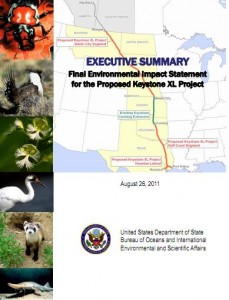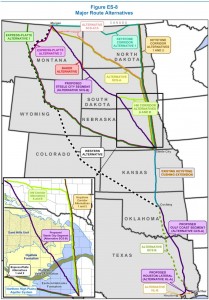
The State Department has issued its Final Environmental Impact Statement on the proposed Keystone XL pipeline. Canadian oil giant TransCanada wants to build across the western half of South Dakota to ship up to 830,000 barrels of tar sands oil per day from Alberta to the Gulf of Mexico. The pipeline may also carry up to 100,000 barrels of Bakken shale oil a day from Montana and North Dakota.
The State Department concludes that the environmental impacts of the Keystone XL pipeline will be minimal. State calculates spill frequency at 1.78 to 2.51 per year and says, no problem! It winks at TransCanada's underestimation of spill risk. It says TransCanada's spill detection plans are adequate, even though they count on landowners and passersby to notice spills.
The FEIS says that over 200 public water supply wells and forty private water wells near the pipeline route face no significant risk because they can get their water elsewhere. The report declares the Keystone XL poses a risk to the Ogallala Aquifer, but only to small portions, not the entire system.
In the eyes of Secretary Clinton's people, these minimal risks do not outweigh the economic demand for more oil. The Gulf refineries will see more demand, asserts the FEIS, and we have to keep oil flowing. The FEIS expresses the usual concern about relying on unstable foreign sources, but the alarm seems to be less that those sources include nasty dictators and more that those sources are drying up. State's argument is more economic than political: we accept the status quo, we aren't interested in using less oil, and the tar sands drillers will move that oil one way or another, so let's dig up our prairie for the pipeline!
The FEIS cites other positive economic impacts, like the temporary pipeline construction jobs and $140.5 million in additional annual property tax revenue. The Teamsters agree, but some union leaders recognize that we could produce a lot more jobs by focusing our attention on renewable energy projects and public infrastructure without risking our prairie or raising our gas prices.

The State Department did consider alternative routes. Running Keystone XL along I-90 is out because the width of Lake Francis Case and the slope on the west side heading toward Chamberlain would pose "technical challenges." Running it down the existing Keystone corridor in eastern South Dakota would cost more and "compromise" the Bakken oil shale link. Because we don't want to make life hard for TransCanada and other Big Oil players, State gives TransCanada what it wants.
The Natural Resources Defense Council says this Final EIS shows State is rushing an unnecessary pipeline (the FEIS timeline sticks to previous promises from the Administration to finally rule on the permit by this December). NRDC points out that the 57 conditions that State touts as evidence of TransCanada's commitment to safety are really a PR stunt repackaging existing minimum requirements for pipeline safety.
The National Wildlife Federation VP Jim Lyon calls this flawed report "strike three":
After two failed rounds of environmental review, this looks like strike three for the State Department. The document still fails to address the key concerns for landowners and wildlife. It is almost certain to be scrutinized in other venues, including a probable legal challenge. This only escalates the controversy in a process that is far from over [Jim Lyon, quoted in Tony Iallonardo, "Flawed Review Gives Tar Sands Pipeline Rubber Stamp for Now," National Wildlife Federation press release, 2011.08.26].
Meanwhile, as of this morning, 381 people have gone to jail to send the message to President Obama that America should not sacrifice its prairie wetlands and property rights for a Canadian company's profits. The protesters are taking a break for Hurricane Irene—and indeed, with a big storm coming, police have more important things to work on than tying up peaceful protesters sitting too close to the White House. The Tar Sands Action folks do note that their protest and the coming storm are connected:
It does not escape our attention that storms of this size and character will be the new normal on a warmer planet. We are more committed than ever to continuing our campaign to stop Keystone XL and the tar sands development, and we will be back in action Monday [Tar Sands Action, "Weather Update for 8/27 and 8/28," 2011.08.26].
You don't have to go to jail to let the State Department know you disapprove of the idea of digging up another long stretch of South Dakota to help a Canadian company ship more oil to China. The State Department is taking public comment at a meeting Thursday, September 29, 2011, at the Pierre Ramkota, from noon to 3:30 p.m. and 4:00 to 8:00 p.m. (You can check this PDF schedule for dates and times of other Keystone XL FEIS meetings in Port Arthur, TX; Austin, TX; Midwest City, OK; Topeka, KS; Lincoln, NE; Atkinson, NE; Glendive, MT; and Washington, DC.)
p.s.: Now help me out, conservatives. This FEIS is Hillary Clinton and Barack Obama telling you that a project is perfectly safe. Shouldn't your alarm bells be going off, conservatives? Shouldn't those of you who booed the Army Corps of Engineers for incompetence last week be bringing your jeers and signs to the State Department's meeting in Pierre on September 29? (Oops, sorry: no signs or banners allowed.)

"It does not escape our attention that storms of this size and character will be the new normal on a warmer planet."
How do we know that? Because the pundits say so? Because a judge says so (as one did in England, in regards to ice cap melting and the Gulf Stream)?
Irene was a big storm but it could have been a whole lot worse. I searched around the cities on the coast and couldn't find a single place where the wind actually reached hurricane force at the surface (a sustained blast of 74 mph or more, based on a one-minute average).
Irene pales in comparison to past storms such as Hurricanes Carol and Hazel (1954), the "Long Island Express" (1938), Donna (1960), or Gloria (1985). Carrying this theme further, I submit:
http://en.wikipedia.org/wiki/List_of_New_England_hurricanes
End of blant (blog rant).
Closer to topic: Why am I so not surprised that the Obama administration comprises crony capitalists?
Well, maybe we can make China dependent on North American oil -- and water from the Ogallala aquifer.
I'm kind of late in studying this in detail. So my questions may be foolish ones. (But that's never stopped me before.) It seems as though this project assumes that the refining of this crude has to be done in the Gulf Coast. Why? There are clearly other, shorter routes to seaports closer to the oil source. Why not build some new refineries in or around Vancouver? Or expand the refinery operations in Billings?
Also, is the argument that we shouldn't be making plans to refine and burn this crude, because of the danger to the atmosphere? Or that we don't want to assume the risk of having it spill into our aquifers, etc. on its way to the refineries? Or both?
Bill asks questions that get at the underlying issues in the Keystone project.
As Cory points out, the EIS does examine alternatives to the pipeline but it tends to gloss them. The pipeline will supply crude to 58 refineries in the Gulf, which have been supplied by oil from Mexico, Venezuela, Saudi Arabia, and Nigeria. The Mexican and Venezuelan supplies have been diminishing, and for political reasons the U.S. would rather run on Canadian oil. As for refineries in other places, the Canadians think drilling the tar sands creates as much environmental mess as it wants to deal with, and the oil companies do not want the expense of shipping by tanker. No one else, as is the case with Hyperion, really wants refineries, either.
Some business and labor in Canada have protested the pipeline because it will create some jobs in the U.S. rather than create more for the Canadians. While the Obama administration is making some compromises to maintain a transitional supply of oil while it tries to move the U.S. into renewable energy, it is coming up short in creating jobs in the renewable field and in creating resources in trying to meet the demand for oil.
The openly professed mission of Obama's opponents to work diligently for his failure and to obstruct any of his initiatives, with some emphasis on renewable energy, is factor that weighs heavily on the Keystone decision. This EIS opens up the crucial comment period, and provides a time for critical information to be presented and questions to be asked. The danger for the Obama administration is that its conciliatory posture to the oil industry may give oil interests the political wherewithal to maintain its control of the energy economy. You know: take your Prius and shove it.
Thank you David, for bringing me up to speed.
Bill, that is stupid. He took you backwards. On one hand Newquist blasts business people as greedy and on this one he says they (with the approval of our federal government) is supporting it to hurt Obama. The guy sees conspiracy in everything. Goofy is kind.
It is late and I dont have energy to address except can I invoke the Jefferson quote you did?
Really.
Which part of Mr. Newquist's overview did you find lacking, Mr. Jones?
Perhaps after you've rested...
(p.s. fire away, Troy...with one proviso... it seems every time I invoke the Jefferson ridicule rule, I get ridiculed for it ;^)
This does point to the problems of central planning instead of allowing the common folks use their common sense in a free market that is protected from the coercion and force that is present in both political parties.